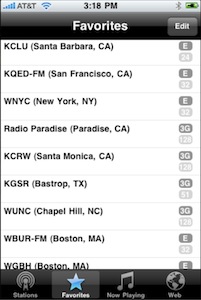 The great Larry Josephson — to me the best radio host ever (he was real and honest and funny and groundbreaking and smart long before Howard Stern was the same, and I am a serious Howard fan too) — once explained his radio philosophy to me in two words:
The great Larry Josephson — to me the best radio host ever (he was real and honest and funny and groundbreaking and smart long before Howard Stern was the same, and I am a serious Howard fan too) — once explained his radio philosophy to me in two words:
It’s personal.
From the beginning we have regarded broadcasting as a one-to-many matter, even though the best broadcasters know they are only talking to single pairs of ears, and usually act the same way. Yet stations, programmers and producers put great store in numbers, also known as ratings. Stations, even public ones, lived and died by “The Book” — Arbitron’s regional compilations of results.
At this point something like 2.5 million Public Radio Players — radios for the iPhone — have been downloaded. To the degree that the PRP folks keep track of how much each station and program gets listened to, the results are far different than what Arbitron says. See here for the results, and see here for one big reason why.
At this point Public Radio Player (with which I have some involvent) and other ‘tuners’ for the iPhone (such as the excellent WunderRadio) are my primary radios. I use them when I’m walking, driving, or making coffee in the kitchen at home. I listen to KCLU from Thousand Oaks/Santa Barbara here in Boston, I listen to WBUR, WUMB, WERS, WEEI (Celtics basketball) and other Boston stations when I’m in California. My list of “favorites” (such as the list above, on Wunderradio) runs into the dozens, and includes programs as well as stations. Distinctions between live, podcast, on-demand (podcasts served by stations, live) and other modes are blurring.
Three things are clear to me at this point. First is that it’s very early in this next stage of what broadcasting will become. Second is that it’s more personal than ever. Third is that the time will come when we’ll shut down many (if not most or all) terrestrial transmitters.
On this last topic, a number of landmark AM stations that I grew up listening to — CBL/740 from Toronto, and CKVL/850, CBF/690 and CFCF/940 from Montreal — are all gone. The last two of those went off in January. Those were “clear channel” powerhouses, with signals you could get across the continent at night. I could even get CKVL in the daytime in New Jersey. Now: not there. But the decendents of all those stations are available on the Net, which means they’re available on smartphones with applicatons that play streams. While it’s still not easy to serve streams to thousands (much less millions) at a time, it’s also cheaper than running transmitters that suck 100,000 watts and more off the grid and take up large amounts of real estate (including open land for AM and the tops of mountains and buildings for FM). Not to mention that broadcast towers (which run up to 2000 feet in height) are hazards to aviation, bird migration and surrounding areas when they collapse, which is often.
Anyway, I’ve always thought the ratings were good for the mass-appeal stuff, but way off for stations and programs that appealed to many — but not to enough to satisfy the advertising business. Personal listening is much more idiosyncratic, but also much more interested and involved, than group listening, which actually doesn’t happen.
Therefore I expect radio, or its next evolutionary stage, to be more personal than ever — and therefore better than ever.
Bonus link: JP Rangaswami’s Death of the Download. His closing lines:
And what if the customers have given up and moved on, from the download to the stream?
It was never about owning content. It was always about listening to music.
It was never about product. It was always about service.
The customer is the scarcity. We would do well to remember that. And to keep remembering that.
Leave a Reply